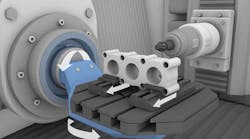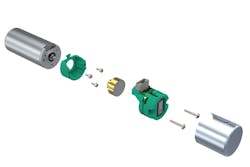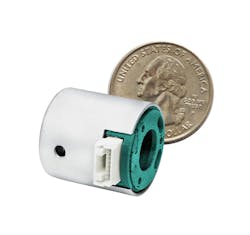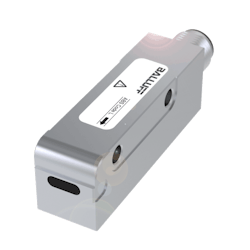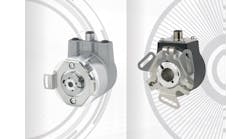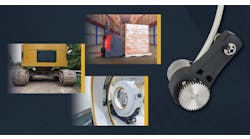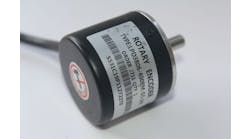Machine builders have many choices for measuring position, count, speed or direction of a mechanism. In choosing an encoder, the specific application should guide the design. Determining what accuracy is needed, what conditions the encoders will operate in and other mechanical restrictions will help to guide selection. Two manufacturers, Posital-Fraba and Balluff offer some encoder options for measuring rotation in small servo and stepper motors and linear measurement via a magnetic absolute encoder.
Where incremental encoders indicate movement from one position to the next, not a specific position, absolute encoders will indicate when position has changed and the location of that position relative to shaft rotation. Absolute encoders are the best choice when exact position needs to be known.
Small, light package
To provide position feedback for small servo or stepper motors, Posital-Fraba offers the 22-mm absolute rotary kit encoder. This is smaller and lighter than Posital’s other modular encoders. The kit is built into a package that is 22-mm diameter (vs. 36-mm) and 35 g (vs. 45 g). “The small diameter makes it a great fit for the compact 22-mm dc motors sold by many manufacturers,” says Christian Fell, head of Posital operations in North America and vice president for technology development. “The multi-turn measurement range is especially valuable when motors are connected to reduction gears, screw shafts, spools or other mechanisms where position changes involve multiple motor rotations.”
Unique to this kit encoder is its self-powered multi-turn rotation counter system, which is energized by Posital’s Wiegand energy-harvesting technology. “The complete rotation history is accurately recorded, even when rotations take place while system power in unavailable,” Fell says. “As the counter system generates its own power, there is no need for installing, testing and replacing backup batteries.”
Fell says the system is ideal for position-control tasks in manufacturing equipment, mobile machinery, medical equipment and many other tasks. ”Absolute encoders are instruments that measure the rotation angle of a mechanism and report it to the control system as a digital message,” Fell says.
The encoder’s self-powered multi-turn measurement range supplies a complete picture to the controller of the absolute position of the mechanism driven by the motor. “There is no need to re-home equipment and re-initialize the rotation count in the event of a system restart. This is unlike incremental encoders, which send out a signal each time the shaft rotates by a specific amount, leaving the controller with the task of continuously updating the rotary position,” Fell says.
The Posital absolute encoder kit uses magnetic-measurement technology based on multiple Hall-Effect sensors and signal-processing algorithms. The Hall-Effect-based sensor system is designed to determine the angular position of the shaft according to the direction of a permanent magnet’s magnetic field. The permanent magnet is attached to the shaft, and its magnetic field penetrates the Hall sensor.
The Hall-Effect based sensor system is the single-turn stage of the absolute encoders. However, it doesn’t enable the encoder to count revolutions if the external power supply is disconnected. Posital solves this problem by means of an energy-harvesting system based on the Wiegand effect, which requires no batteries or gears.
[javascriptSnippet ]
End of travel
For applications where position accuracy is necessary and end of travel is required, the Balluff absolute magnetic linear encoders with Siemens Drive-Cliq interface offer plug-and-play installation and high accuracy.
“The BML absolute rotary magnetic encoder systems from Balluff ensure absolute positional feedback in every position,” says Scott Rosenberger, after-sales technical support engineer for Balluff. “They can be used immediately, without a reference run.” The encoders are tested and certified by Siemens and integrate into Siemens motion-control environments.
“It’s a way for us to make it easier for customers already using Siemens to incorporate Balluff products into Siemens architecture,” Rosenberger says. Siemens is a major player, especially in Europe, where this product was developed, he explains.
“Plug-and-play installation makes incorporating them into the drive system easy,” says Rosenberger. The encoders are designed to integrate with Siemens motion controller environments.
“The controller automatically detects the sensor and its basic settings,” Rosenberger says. “It’s automatic status monitoring continuously checks the measurement quality, detecting any mechanical position shift during operation.”
The accuracy of the sensor is affected by the measurement quality, Rosenberger says. “The magnetic tape is coded with the absolute positional information,” he explains. “The encoder head reads that position information from the tape and puts out a signal in a serial data format that a control system can read.”
In general, the sensor must be in close proximity to the tape to be effective. “When we talk about measurement quality, we’re talking about factors that can affect that, such as the sensor head not being aligned with the tape or too far away, or the tape is physically damaged,” Rosenberger says. “In the case of this product, it can transmit, and, if it starts to sense that it’s not optimally seeing the tape, it can inform the controller that measurement quality is less than optimal and action is needed by the user.”
Balluff offers two Siemens certified encoder versions—BML085L and BML08MH—providing 1 m position resolution and a stroke length of up to 48 m. “Equally impressive is the system of accuracy of +/- 12 m and high read distance of. 1.3 mm,” Rosenberger says. Additionally, the BML08MH version has an input for a temperature sensor. That data is rolled into the position information and integrated all from one source.
The encoder is made for applications that require accurate x and y axis position data, such as industrial cutting systems or a large industrial printer for billboard panels or large-scale graphics. Rosenberger says the sensor is also well-suited for demanding applications because the magnetic tape and the sensor don’t touch each other. “There is no mechanical wear, nor are they affected by dirt or dust or grim,” Rosenberger says.
The BML larger portfolio of magnetic encoder systems is designed for linear or rotary motion, position or angle measurement, format changes or short- or long-distance measurement. Balluff magnetic encoders provide absolute measurement by traveling above a magnetically coded strip that can be up to 8 m long, with a read distance of 1.3 mm.
The encoders meet IO-Link’s smart sponsor profile 2.0 specifications, adding four switching signal channels to the process data, says Rosenberger. “Each channel uses IO-Link to program an on and off point for the encoder, which allows measurements to be limited to set ranges or windows,” he explains.
To support the switching signal channels, the encoders send 2 additional bytes of processing data. “Without this, you would need to use additional sensors to set these limits,” Rosenberger says. Using IO-Link, the encoders send digital measurement data to the network or provide an optional analog real-time sine-cosine signal for control applications. To report signal quality, the line’s enhanced version adds condition-monitoring functions.
Anna Townshend has been a writer and journalist for almost 20 years. Previously, she was the editor of Marina Dock Age and International Dredging Review, published by The Waterways Journal, until she joined Putman Media in June 2020. She is the managing editor of Control Design and Plant Services. Email her at [email protected].
